Engineering managers' guide to performance reviews in 2025
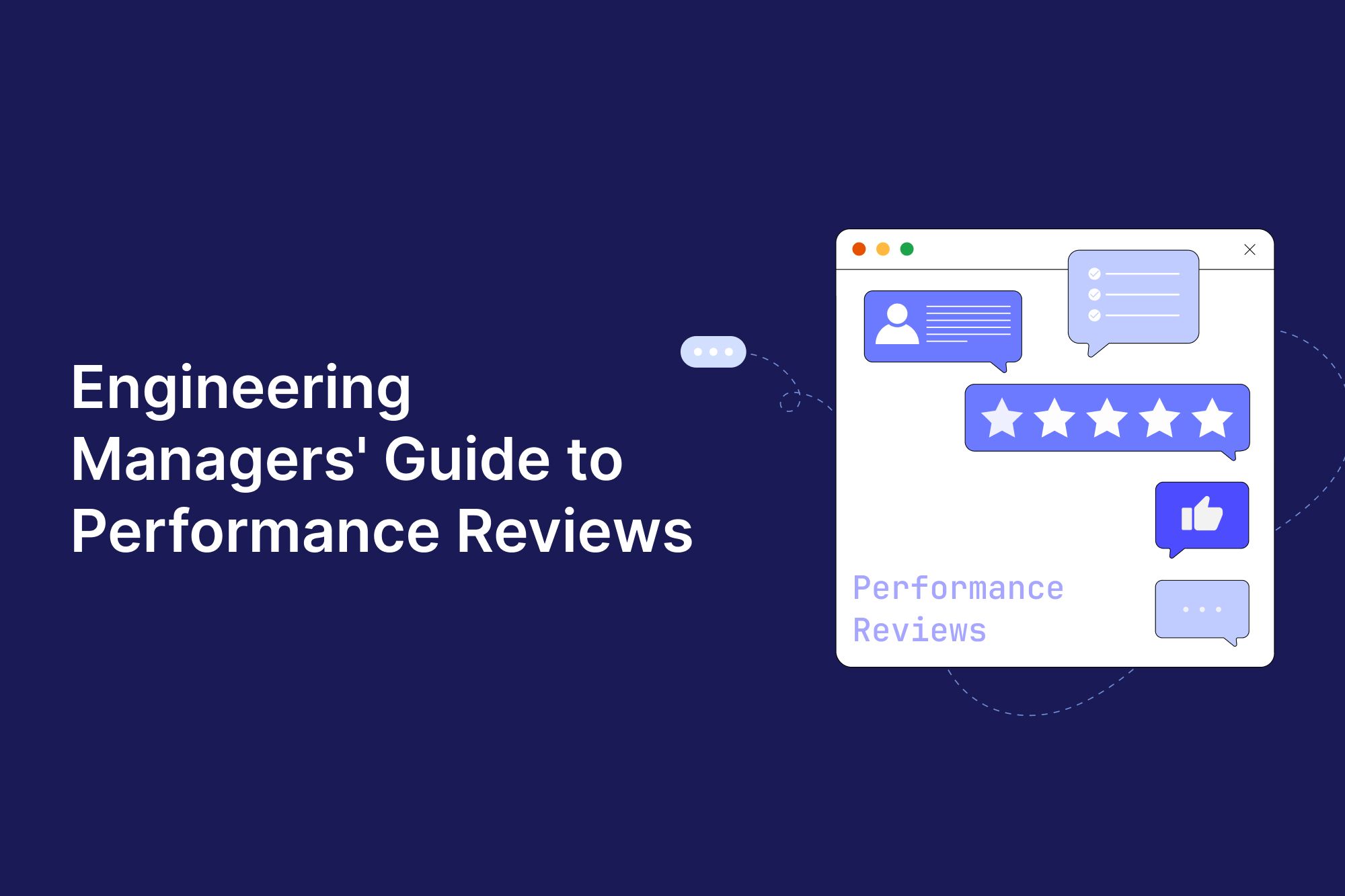
The responsibility of an Engineering Manager (EM) goes beyond just overseeing projects; it's about nurturing a team's growth, fostering innovation, and driving performance to new heights. As the tech landscape evolves, so does the approach to performance management, making it a critical aspect of an EM's toolkit. Whether you're a seasoned manager or stepping into the role for the first time, understanding how to leverage insights for effective performance reviews is key to unlocking your team's potential and aligning individual achievements with your organization's goals.
In this article, we will discuss the nuances of performance management, from setting clear goals and establishing relevant performance metrics to strategically using tools and software that provide actionable insights into your team’s performance. So, let’s dive in!
How Old-School Methods Keep Frustrating Managers and Devs

1. The Data Mess
As an engineering manager, you’re juggling tools like Jira, GitHub, and Slack. But when it’s time to evaluate performance, none of these tools give you the full picture. Instead, you’re left toggling between tabs, hoping you’re not missing something important.
2. What About the Quiet Contributors?
Not all great work is loud and visible. The dev quietly cleaning up legacy code or mentoring juniors often goes unnoticed in traditional reviews. Without tools to highlight this work, their contributions might not get the recognition they deserve.
3. Vague Feedback Isn’t Helpful
Generic feedback like “Do better” or “Great job” doesn’t cut it. Developers need specific, actionable insights to grow. But pulling together those insights from multiple sources is easier said than done.
A New Era: Let AI Do the Heavy Lifting So You Can Focus on People
How do we finally make performance reviews less about panic and more about progress? We start by recognizing that reviews are fundamentally about people, not just metrics. While AI can gather and organize data from GitHub, Jira, and Slack in ways we never thought possible, it’s the human connection—recognizing quiet wins, acknowledging real struggles, and celebrating personal growth—that truly transforms the process.

Imagine having a single, organized snapshot of every code commit, conversation, and small-but-crucial contribution, without having to chase down a dozen browser tabs. AI can filter the signal from the noise, freeing you up to focus on what really matters: guiding your team members, understanding their challenges, and helping them grow. No more guesswork, no more “I think I did something important three months ago” moments just clarity and compassion.
By leaning on AI for the mundane tasks of gathering and summarizing data, you reclaim the headspace to actually talk to your developers about their goals, recognize the behind-the-scenes heroes, and offer real support when they need it. In the sections ahead, we’ll explore how to strike that balance: harnessing technology for efficiency while keeping the human element front and center. Let’s see how we can make performance reviews work for everyone involved.
Defining Success: Performance Metrics That Truly Matter
EMs should develop a broad range of performance indicators in order to evaluate the performance of their team fully. Code quality measures, such as bug density and code review feedback, productivity metrics and tasks performed, and innovation metrics, such as newly developed features and filed patents, are examples of possible metrics.
Code Quality
This metric measures the codebase's efficiency, maintainability, and reliability. It takes into account things like code reviews, test coverage, code complexity, and standardization of coding practices. Reduced bugs, easier maintenance, and improved program performance are all results of high code quality.
Productivity
The engineering team's output and efficiency are tracked by productivity indicators. Metrics like burn-down charts, which show the progression of a collection of activities towards completion visually, and velocity, which measures the quantity of work done in a specific length of time, can be examples of this. Tracking productivity makes it easier to find bottlenecks, streamline procedures, and guarantee project delivery on schedule.
Innovation
Innovation metrics assess the engineering team's ability to come up with fresh concepts, try out cutting-edge fixes, and add or enhance inventive features. Metrics like the number of new concepts introduced and the success rate of innovation projects are some performance indicators are a few examples of this. Creating an innovative culture inside the team boosts productivity, stimulates invention, and keeps them ahead of the competition.
Balancing Numbers and Nuance
Sure, metrics like bugs fixed and features shipped tell you what got done. But they don’t show you how a developer collaborates or why they made certain decisions. That’s where qualitative feedback shines—it highlights the behind-the-scenes teamwork, creativity, and mentorship that raw data can’t capture. By blending both sets of insights, you get a fuller picture of each person’s contributions, spark more meaningful conversations, and ultimately build a stronger, more supportive team.
Techniques for effective communication with team members
Methods for having productive conversations with fellow team members: Effective communication creates an atmosphere of trust and cooperation by involving active listening, being clear about expectations, and showing empathy for other team members.
- Active listening promotes understanding and builds trust by focusing entirely on what others are saying without making remarks.
- Clearly communicating ideas ensures that everyone gets the message and helps to prevent misunderstandings.
- Everyone is kept informed about goals, difficulties, and progress through regular meetings and status updates.
- Providing Regular feedback promotes open discussion and continuous growth.
- Information can be communicated smoothly by selecting the right communication channel (like chat, email, or video calls) based on the audience and the content of the message.
- Developing an environment where team members are at ease sharing their ideas and opinions encourages innovation and creativity.
Meet Developer Reports: Bringing Real Clarity to Performance
Developer Reports take the chaos out of performance reviews by giving you a clean, comprehensive view of each developer’s work.
Here’s how they help:
1. See the Whole Story

Instead of piecing together scattered data, these reports bring everything into one place:
- Commits, PRs reviewed, bugs fixed, and features shipped.
- High-impact contributions, like resolving critical issues or introducing innovative solutions.
- Growth trends over time—who’s leveling up, and who needs more support?
2. Spot the Quiet Wins
Some of the most valuable work happens behind the scenes. Developer Reports shine a light on:
- Mentorship contributions, like code reviews and team support.
- The not-so-glamorous but essential work, like debugging or improving system reliability.
- Contributions to team health and collaboration.
This ensures every developer’s efforts are seen and appreciated, even if they’re not shouting from the rooftops.
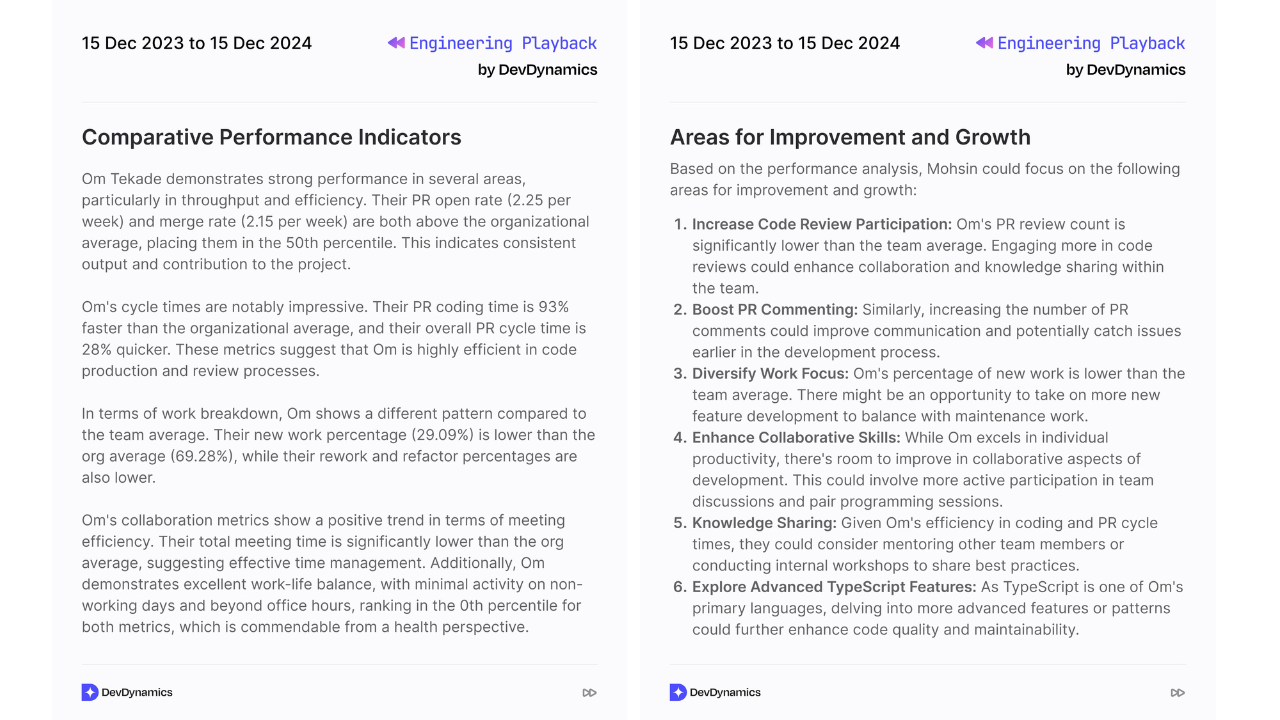
3. Make Feedback Actionable
With metrics like:
- PR lifecycle insights (time to open, review, and merge).
- Collaboration stats (mentoring, team support, and cross-functional work).
- Consistency trends (how their performance stacks up over time).
You’re no longer guessing what to say in reviews. You have the data to back up your feedback, whether it’s recognizing strengths or addressing areas for improvement.
Before, During, and After: Putting These Insights to Work
Before the Review:
Spend a few minutes reviewing the report. It’ll show you what the developer has worked on, where they excelled, and any potential red flags.
During the Review:
Let the report guide the conversation. For example:
- Instead of “How do you think this quarter went?” say, “Your PR merge time improved by 20%, and you mentored three juniors. How did that feel?”
- Or, “I noticed your pickup time on tasks is a bit slower than the team average. Let’s figure out why.”
After the Review:
Use the insights to set measurable goals. Whether it’s improving a specific metric or expanding their responsibilities, the report gives you a baseline to build on.
Keeping Feedback Flowing: Make It a Daily Habit
When team members get feedback often, they can learn and grow faster. It's like having regular check-ins to see what's going well and what could be better. Plus, when everyone talks openly, it helps everyone understand their roles better and reduces misunderstandings. Understanding and listening to each other's concerns makes the team feel closer and more supportive.
Promoting a culture of continuous feedback encourages both professional and personal growth by allowing open discussion and constructive criticism.
Real-Time Context: Zoom In with Developer Profiles
If Developer Reports give you the bird’s-eye view, Developer Profiles let you zoom in on the details.

- Want to see why a project stalled? Check the Activity Tab.
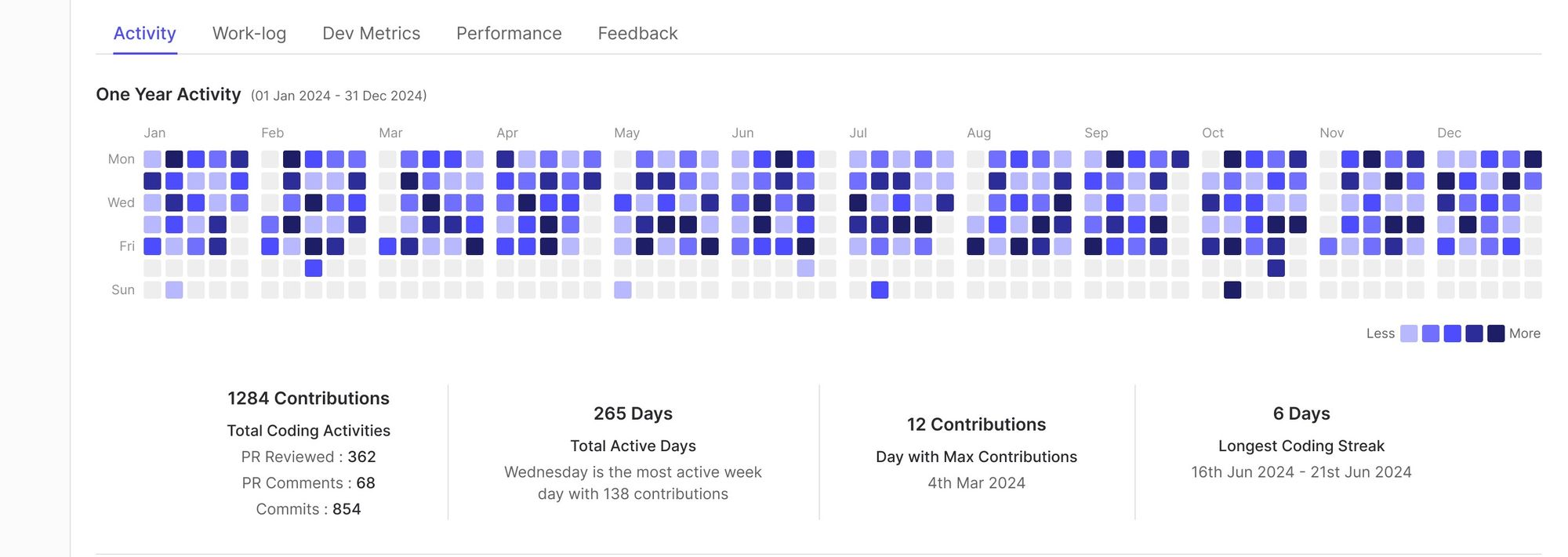
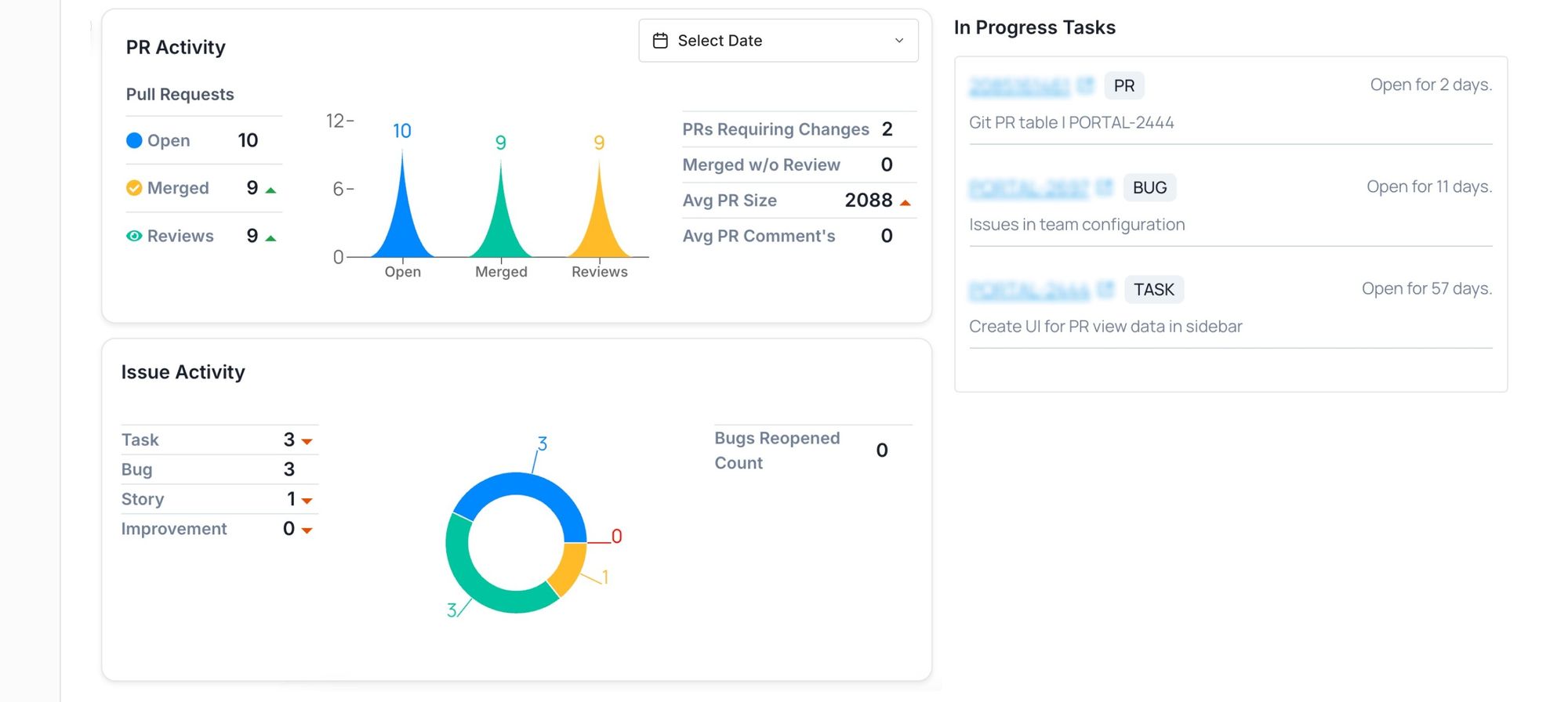
- Curious about collaboration? The Metrics Tab has your answer.
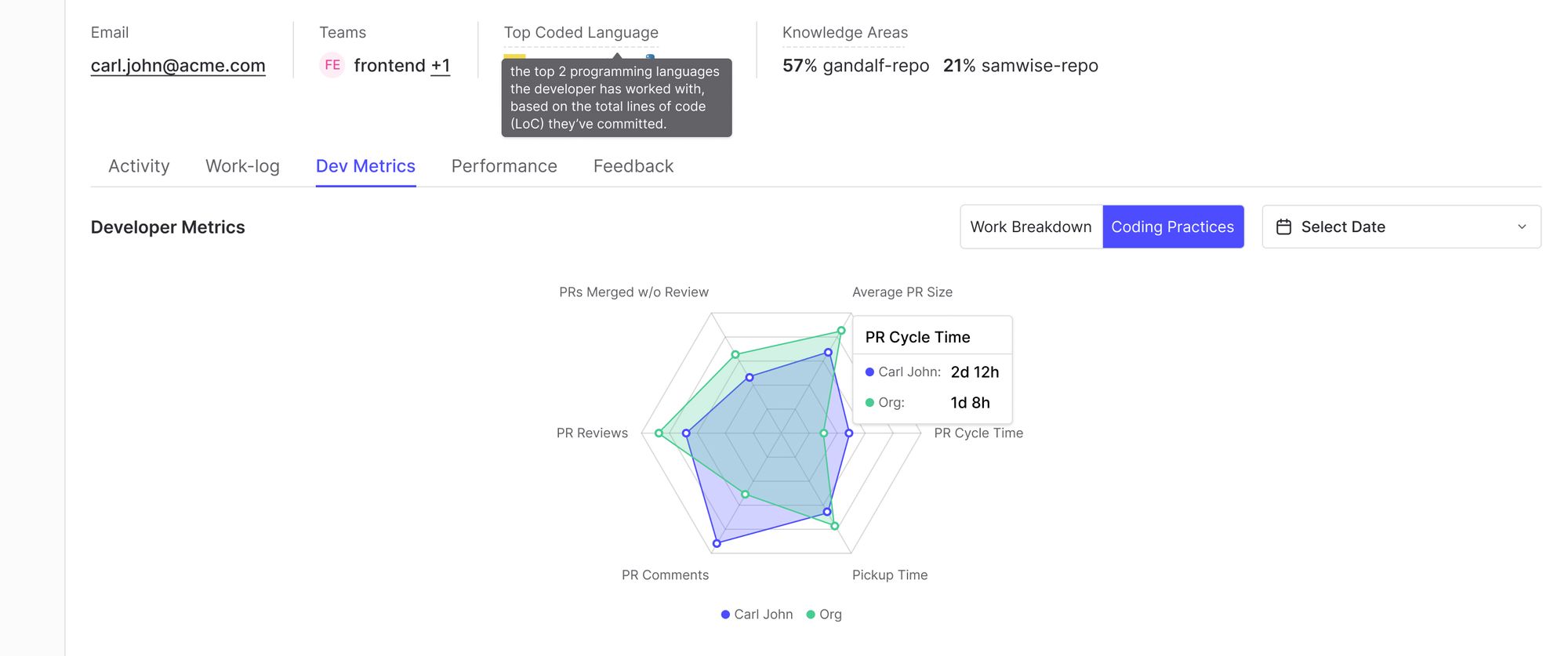
- Preparing for a 1:1? The Work Log Tab breaks down their recent progress.

Together, these tools ensure you’re not just running reviews, you're building a team that’s engaged, motivated, and constantly improving.
Because Performance Reviews Should Work for Everyone
Performance reviews don’t have to feel like pulling teeth. With Developer Reports and Developer Profiles, you get the insights you need to have meaningful, constructive conversations. No more guesswork. No more overlooked contributions. Just clear data and actionable feedback to help your team grow.
Ready to simplify your performance reviews?
📅 Schedule a demo and see how DevDynamics can transform the way you manage your team.

